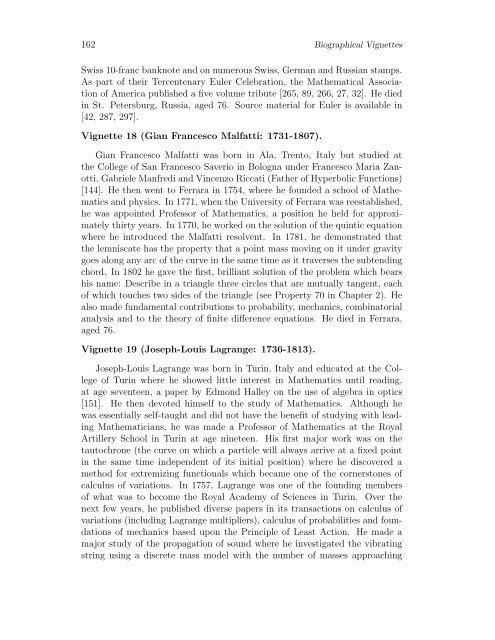MYSTERIES OF THE EQUILATERAL TRIANGLE - HIKARI Ltd
MYSTERIES OF THE EQUILATERAL TRIANGLE - HIKARI Ltd
MYSTERIES OF THE EQUILATERAL TRIANGLE - HIKARI Ltd
Create successful ePaper yourself
Turn your PDF publications into a flip-book with our unique Google optimized e-Paper software.
162 Biographical Vignettes<br />
Swiss 10-franc banknote and on numerous Swiss, German and Russian stamps.<br />
As part of their Tercentenary Euler Celebration, the Mathematical Association<br />
of America published a five volume tribute [265, 89, 266, 27, 32]. He died<br />
in St. Petersburg, Russia, aged 76. Source material for Euler is available in<br />
[42, 287, 297].<br />
Vignette 18 (Gian Francesco Malfatti: 1731-1807).<br />
Gian Francesco Malfatti was born in Ala, Trento, Italy but studied at<br />
the College of San Francesco Saverio in Bologna under Francesco Maria Zanotti,<br />
Gabriele Manfredi and Vincenzo Riccati (Father of Hyperbolic Functions)<br />
[144]. He then went to Ferrara in 1754, where he founded a school of Mathematics<br />
and physics. In 1771, when the University of Ferrara was reestablished,<br />
he was appointed Professor of Mathematics, a position he held for approximately<br />
thirty years. In 1770, he worked on the solution of the quintic equation<br />
where he introduced the Malfatti resolvent. In 1781, he demonstrated that<br />
the lemniscate has the property that a point mass moving on it under gravity<br />
goes along any arc of the curve in the same time as it traverses the subtending<br />
chord. In 1802 he gave the first, brilliant solution of the problem which bears<br />
his name: Describe in a triangle three circles that are mutually tangent, each<br />
of which touches two sides of the triangle (see Property 70 in Chapter 2). He<br />
also made fundamental contributions to probability, mechanics, combinatorial<br />
analysis and to the theory of finite difference equations. He died in Ferrara,<br />
aged 76.<br />
Vignette 19 (Joseph-Louis Lagrange: 1736-1813).<br />
Joseph-Louis Lagrange was born in Turin, Italy and educated at the College<br />
of Turin where he showed little interest in Mathematics until reading,<br />
at age seventeen, a paper by Edmond Halley on the use of algebra in optics<br />
[151]. He then devoted himself to the study of Mathematics. Although he<br />
was essentially self-taught and did not have the benefit of studying with leading<br />
Mathematicians, he was made a Professor of Mathematics at the Royal<br />
Artillery School in Turin at age nineteen. His first major work was on the<br />
tautochrone (the curve on which a particle will always arrive at a fixed point<br />
in the same time independent of its initial position) where he discovered a<br />
method for extremizing functionals which became one of the cornerstones of<br />
calculus of variations. In 1757, Lagrange was one of the founding members<br />
of what was to become the Royal Academy of Sciences in Turin. Over the<br />
next few years, he published diverse papers in its transactions on calculus of<br />
variations (including Lagrange multipliers), calculus of probabilities and foundations<br />
of mechanics based upon the Principle of Least Action. He made a<br />
major study of the propagation of sound where he investigated the vibrating<br />
string using a discrete mass model with the number of masses approaching

















